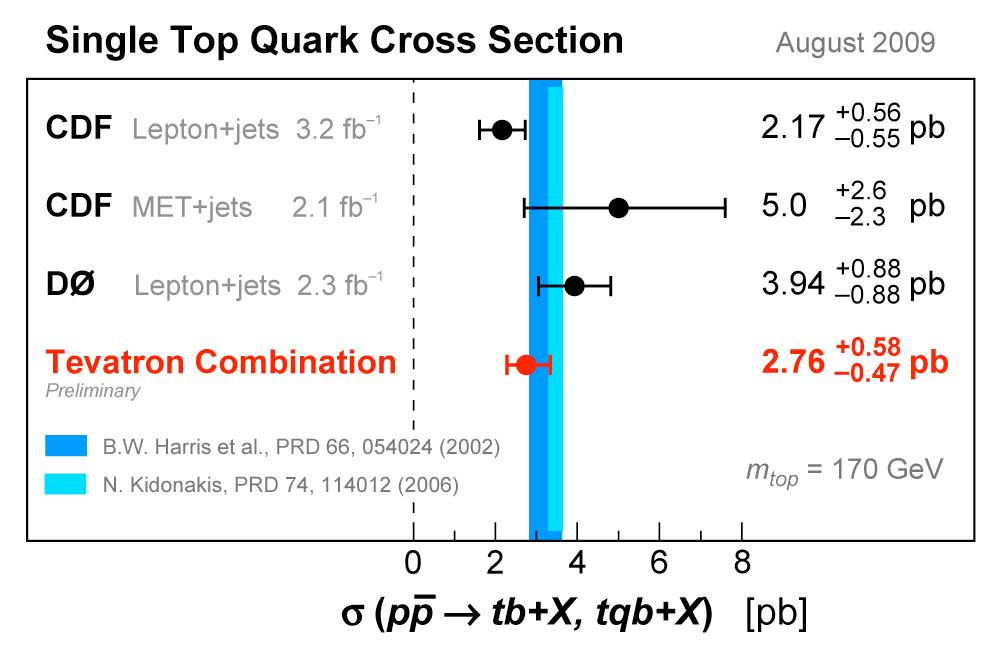The top quark is the heaviest member of a family of six. It has been discovered in 1995 by the CDF and Dzero experiments at the Tevatron, and since then it has been studied in great detail, since its phenomenology provides a lot of information on the theory of electroweak interactions. That is actually kind of strange, since quarks are most of all subject to the strong force, being carriers of the "colour charge". Quarks are tightly bound inside hadrons by the strong force, and electroweak interactions are only affecting their decays. But the top quark is different.
The top quark is special because it is so heavy that it decays blitzingly fast. There is an inverse relationship between the weight of a quark and the life it lives, and top lives as little as 10^-25 seconds: a tenth of a trillionth of a trillionth of a second. During its lifetime, the top quark has no time to bind in a stable relationship with an antiquark -making a meson- or with two other quarks -making a baryon.
Strong interactions have a typical time scale about ten times longer than the top lifetime, so they leave top quarks free. When top decays, it does so by the emission of a W boson, and through the phenomenology of top decay we learn a whole lot about electroweak theory, because the W boson emitted by top quark decay is a real particle, and not a virtual one as in the decay of lighter quarks.
At the Tevatron, the top quark is mainly produced by strong interactions, and since strong interactions cannot materialize a top quark out of nothing (top quarks are basically non-existent in the colliding protons and antiprotons), they rather produce a top-antitop pair, such that the total balance of "top-ness" remains zero after the production.
But top quarks can indeed be also produced by themselves: this occurs by electroweak interactions, which are not bound to conserve the total top-ness of the particles participating in the reaction. When this happens, we have an additional way to study electroweak interactions with top quark physics. Because of this fact, the production of single top quarks has been sought with momentum by CDF and DZERO for quite some time, before they could finally say they had nailed it.
The reason why single top quarks are harder to find than pairs of those bodies is twofold: they are produced at a smaller rate, and the features of the final state are less distinctive, and much harder to separate from backgrounds. But finally we start to have several different measurements of the single top quark cross section from CDF and Dzero, and we can look forward to even more detailed measurements of the production characteristics.
The figure below shows three independent determinations of the single top production cross section at the Tevatron, expressed in picobarns. If you are unfamiliar with this unit, I can tell you that a process with a cross section of a picobarn is produced by proton-antiproton collisions once every hundred billions. Pretty rare, then. Two picobarns means once every fifty billions: simple after all isn't it ?
The three measurements have been combined by taking into account correlated and uncorrelated systematics -two of them come from the CDF experiment, the third one from Dzero. The method is a Bayesian integration over all nuisance parameters, if you are curious. In any case, the final result is very close to the first measurement shown on top, which is by far the most precise. The result (2.76 picobarns, in red) is in great agreement with theoretical predictions (shown by the two blue bands).

Now that we know that electroweak interactions do behave as we expected in the production of top quarks, we can move on to studying their characteristics. This will be a subject on which the LHC is expected to contribute significantly: the higher LHC energy grants a x100 increase in the probability to produce single top quarks, so even one or two years of running will allow CMS and ATLAS to investigate the process in detail.



Comments